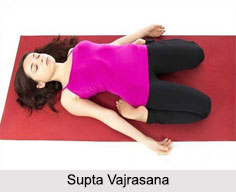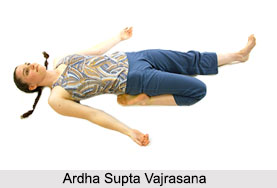 Supta Vajrasana is a reclined version of "Vajrasana" where the upper body reclines backwards, so that the back rests on the floor. The arms rest on the floor to either side of the trunk, with the palms facing up. It is effective in treating constipation, blood pressure and strengthens the abdominal muscles. This is mainly useful in improving the digestive system and boosting the stamina.
Supta Vajrasana is a reclined version of "Vajrasana" where the upper body reclines backwards, so that the back rests on the floor. The arms rest on the floor to either side of the trunk, with the palms facing up. It is effective in treating constipation, blood pressure and strengthens the abdominal muscles. This is mainly useful in improving the digestive system and boosting the stamina.
Etymology of Supta Vajrasana
In Sanskrit, the word "Supta" means "reclined", "Vajra" means "thunderbolt" and Asana means "posture". While performing this asana, one lies on his or her back with folded legs. Hence, it is called "Supta Vajrasana".
Variations of Supta Vajrasana
Supta Vajrasana is also known as `Supta Virasana` (Reclined Hero Pose) and has minor variations like `Eka Pada Supta Vajrasana` (One-Legged Reclining Thunderbolt Pose) or `Ardha Supta Vajrasana` (Half-Reclined Thunderbolt Pose) which involves one leg folded under the body while the other is being stretched. Although there are 14 variations in this Supta Vajrasana, practicing one and mastering it is enough to tone the body.
Steps to Practice of Supta Vajrasana
The following are the steps to practice the Supta Vajrasana pose:
Sit in Vajrasana.
Placing the palms on the floor beside the buttocks, fingers pointing to the front.
Slowly bend back, placing the right forearm and the elbow on the ground and then the left.
Bring the crown of the head to the ground while arching the back. Place the hands on the thighs.
Try to keep the lower legs in contact with the floor. If necessary, separate the knees.
This pose is held for 30 seconds. Make sure that do not overstrain the muscles and ligaments of the legs.
Close the eyes and relax the body. Breathe deeply and slowly in the final position.
Release in the reverse order, breathing in and taking the support of the elbows and the arms raise the head above the ground.
Then shift the body weight on the left arm and elbow by sliding the body, then slowly coming to the starting position.
Never leave the final position by straightening the legs first. It may dislocate the knee joints.
Repeat the above process for 3-5 times and increase it to 8-10 times as mastering it. Supta Vajrasana is also practiced in combination with "Pavan Muktasana" for improving the complete digestive system and intestines.
 Effects of Supta-Vajrasana
Effects of Supta-Vajrasana
The helpful effects of practicing Supta Vajrasana are as follows:
1. Supta-Vajrasana strengthens abdominal and thoracic muscles.
2. This cultural asana is useful in high blood pressure and sciatica.
3. It is a good remedy for constipation.
4. People, who suffer from breathing problems such as asthma or even bronchitis, get relief by practising this asana.
5. It strengthens the thigh muscles.
6. It brings flexibility of the spine.
7. It helps to eliminate anger, aggression and relax the mind.
Precautions for Supta Vajrasana
Following are the precautions to be taken before or while practicing Supta Vajrasana:
1. Those suffering from gastritis and pain in hip should not practice it.
2. Should not practice in case of very high blood pressure, slipped disc or those who suffer from vertigo.
3. Should avoid Supta Vajrasana if having knee injuries or surgery.
4. Should not perform after having meal.



